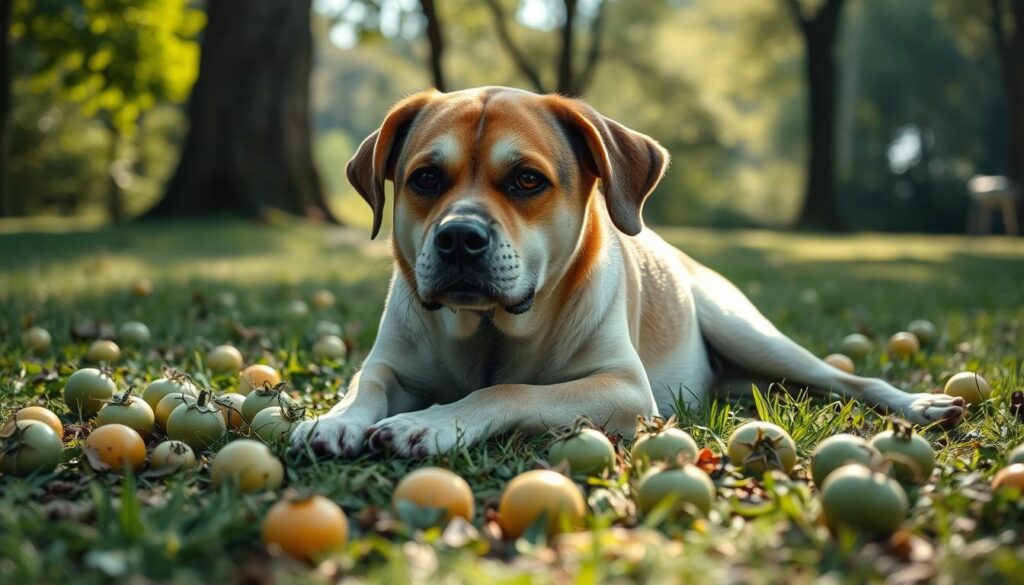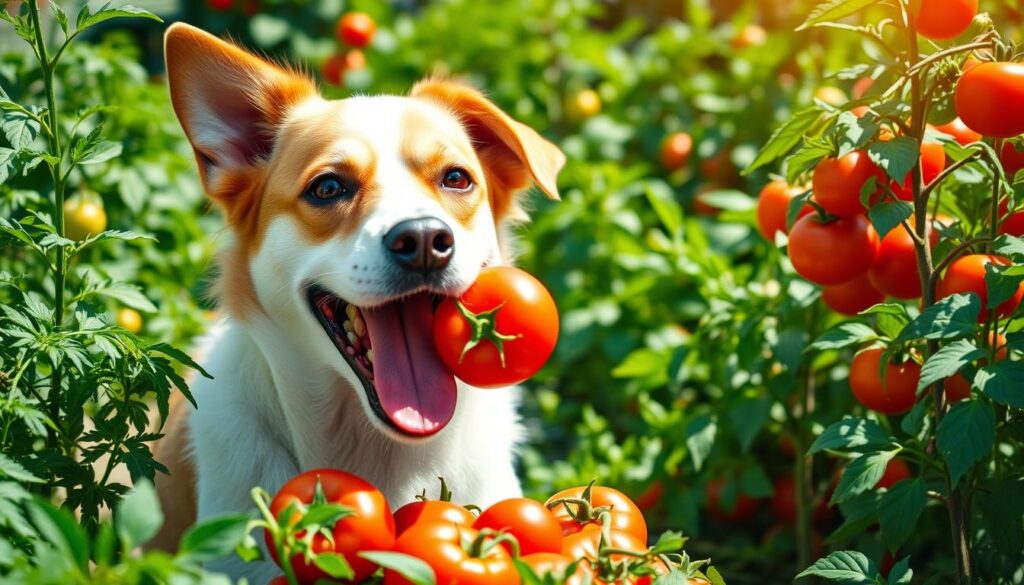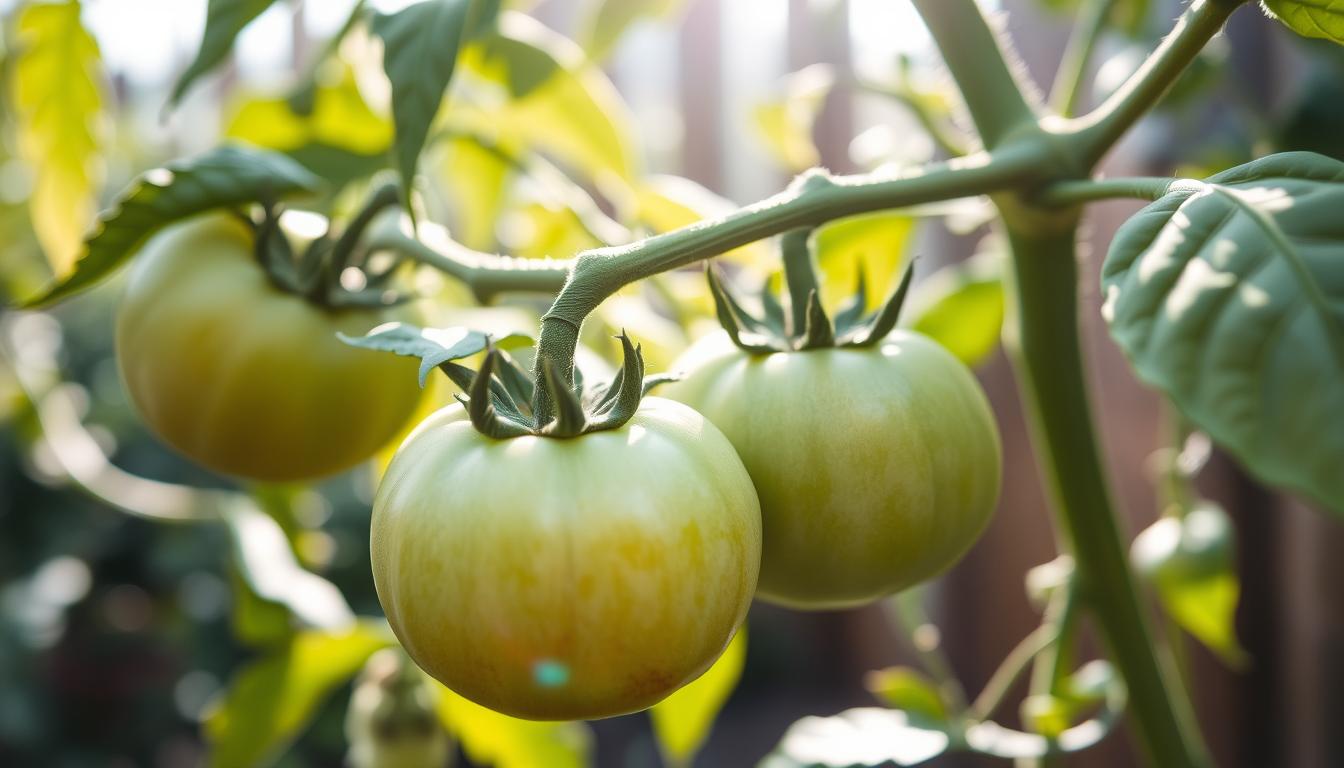As a pet owner, you might be surprised to find out that not all tomatoes are safe for dogs. Ripe, red tomatoes are okay, but unripe, green tomatoes are a different story. If your dog eats an unripe tomato, it could be risky. Let’s dive into what might happen and why it’s a concern.
Table of Contents
Understanding Tomato Toxicity in Dogs
The Nightshade Family and Its Risks
Tomatoes belong to the nightshade family. This family includes plants like potatoes, eggplants, and peppers. These plants have toxins that can harm dogs.
Differences Between Ripe and Unripe Tomatoes
Ripe tomatoes are safe for dogs in small amounts. They offer fiber, vitamins C and K, and antioxidants. But, unripe tomatoes and green parts have more toxins.
These toxins, tomatine and solanine, can be dangerous for dogs. The ripening process lowers these toxins. So, ripe tomatoes are safer for dogs.
But, even ripe tomatoes should be given in small amounts. Large amounts can upset a dog’s stomach.
| Ripe Tomatoes | Unripe Tomatoes |
|---|---|
| Generally safe in small amounts | Contain higher levels of tomatine and solanine, which are toxic to dogs |
| Provide beneficial nutrients like fiber, vitamins C and K, and antioxidants | Pose a greater risk of poisoning if consumed in significant quantities |
| Ripening process reduces toxin levels | Green parts of the plant, such as leaves and stems, also contain these toxins |
Knowing the difference between ripe and unripe nightshade plants toxic to dogs is key. It helps keep your dog safe and healthy.
What Happens If a Dog Eats an Unripe Tomato?
If your dog eats an unripe tomato, it’s key to know the risks. Unripe tomatoes and their green parts have more toxins like tomatine and solanine. These can harm your dog’s health if they eat too much.
Eating an unripe tomato can cause mild to severe problems in dogs. Symptoms include vomiting and diarrhea. Dogs might also feel very tired, weak, have big pupils, or even heart issues. Small dogs and puppies are more at risk because of their size.
Unripe tomatoes and green plant parts are more toxic. But, ripe red tomatoes have less toxin and are safer for dogs to eat in small amounts.
If your dog eats an unripe tomato or plant parts, watch them closely. Get vet help right away if they show bad symptoms. Quick action can help avoid serious health problems.
Tomatine and Solanine: The Dangerous Compounds
Tomato plants have two main toxins that can harm dogs – tomatine and solanine. These are most concentrated in the plant’s green parts, like stems, leaves, and unripe fruits.
Where These Toxins Are Found
Tomatine and solanine are found in tomato plants. They are most present in the green, unripe parts. As tomatoes ripen and turn red, these toxins decrease, making ripe tomatoes safer for dogs.
Concentration Levels in Green Parts
Green, unripe tomatoes have much more tomatine and solanine than ripe ones. This makes the green parts of the plant, like stems and leaves, dangerous for dogs. Even a little bit of these toxins can upset a dog’s stomach and cause serious health problems.
Solanine and tomatine are natural toxins in tomato plant leaves, stems, and unripe green tomatoes. Symptoms in dogs include upset stomach, tiredness, weakness, and neurological issues like confusion or seizures.
The dog’s size, breed, and how much plant they eat can affect how bad the symptoms are. If a dog eats any tomato plant, it’s important to see a vet right away. The toxins can be very dangerous in large amounts.
Recognizing Signs of Tomato Poisoning in Dogs
If your dog eats unripe tomatoes or tomato plants, watch for signs of poisoning. Symptoms of tomato poisoning in dogs include vomiting, diarrhea, and stomach pain. They might also have trouble walking, feel weak, drool a lot, have big pupils, and in bad cases, shake or have seizures.
Your dog might show signs they ate an unripe tomato like being tired, not wanting to eat, and heart problems. If you see any of these signs, get your dog to the vet right away. Waiting too long can make things worse.
| Symptom | Description |
|---|---|
| Gastrointestinal Distress | Vomiting, diarrhea, abdominal pain |
| Neurological Symptoms | Loss of coordination, muscle weakness, tremors, seizures |
| Other Signs | Hypersalivation, dilated pupils, lethargy, loss of appetite, cardiac issues |
Get your dog to the vet fast if you think they ate unripe tomatoes or plants. The bad stuff in these can hurt your dog’s health a lot. So, act fast to keep your dog safe.

Emergency Steps After Unripe Tomato Ingestion
If your dog eats unripe tomatoes or tomato plant parts, act fast. First, remove any plant material to stop them from eating more. Then, watch your dog closely for signs of tomato poisoning.
Immediate Actions to Take
If your dog eats unripe tomatoes or tomato plant parts, do these things right away:
- Remove any plant material from your dog’s area to stop them from eating more.
- Watch your dog for a few hours for signs like vomiting, diarrhea, lethargy, or lack of coordination.
- Call your vet if you see any worrying signs or behaviors.
When to Contact Your Veterinarian
If your dog shows signs of what to do if dog eats unripe tomato or dog tomato poisoning treatment, call your vet right away. Your vet might suggest making your dog vomit or other treatments. Tell your vet how much and what kind of tomato plant your dog ate to help with treatment.
Acting quickly and getting vet help is key in handling what to do if dog eats unripe tomato situations. By doing these things, you can keep your dog safe and healthy.
Safe Ways to Feed Tomatoes to Dogs
Can dogs eat tomatoes safely? Yes, they can, but with some important rules. Ripe, red tomatoes are a healthy snack for dogs. But, you must be careful how you give them to your dog.
Don’t give your dog unripe, green tomatoes or tomato plant parts. These have more tomatine and solanine. These toxins can harm dogs if they eat too much.
- Only give ripe, red tomatoes that are clean of pesticides.
- Cut tomatoes into small pieces to avoid choking.
- Start with small amounts and watch for any bad reactions.
- Tomatoes should not make up more than 10% of your dog’s daily food. Give them out no more than once or twice a week.
Don’t give your dog tomato-based foods like sauces or ketchup. These can have harmful ingredients like salt, onions, or garlic.
By following these easy steps, you can give your dog tomatoes safely. This way, they can enjoy tomatoes as an occasional treat without risking their health.
Preventing Access to Tomato Plants and Gardens
It’s important to keep your dog safe from tomato plants. To do this, you need to take steps to keep them away. Fencing off areas with tomatoes can help keep your dog from getting too close.
Garden Safety Measures
Use strong barriers that dogs can’t knock over or dig under. This will keep your dog away from tomato plants. You might need taller fences or buried wire mesh to keep them out.
Indoor Plant Precautions
Keep tomato plants out of your dog’s reach indoors. Place them on high shelves or in hanging planters. Always watch your dog when they’re outside near tomato plants. Use pet-safe deterrents to keep them away from your garden.
By following these steps, you can keep your dog safe from tomato plants. A safe and dog-friendly garden is key to your pet’s health.
Health Benefits of Ripe Tomatoes for Dogs
Are tomatoes good for dogs? Yes, ripe tomatoes can be a healthy treat for dogs in small amounts. They are full of fiber, which helps with digestion. Tomatoes also have antioxidants like lycopene, which may protect against some diseases.
Tomatoes are packed with vitamins and minerals that are good for your dog. For example, potassium helps keep nerves, muscles, and the heart healthy. Vitamin C boosts the immune system, and vitamin A supports bone growth and a strong immune system.
The fiber in tomatoes can help with weight control and a healthy gut. Tomatoes also have B9 (folic acid) and K1 vitamins, which are good for DNA, cellular reproduction, and blood clotting.
Tomatoes also contain chlorogenic acid, an antioxidant that may help fight free radicals. This could help reduce arthritis in dogs.
But, it’s important to only give your dog ripe, red tomatoes. Green, unripe tomatoes have more solanine and tomatine, which are toxic to dogs.
While tomatoes have many benefits for dogs, they should not be a big part of their diet. Always talk to your vet before adding new foods to your dog’s diet.

Conclusion
Ripe tomatoes are okay for dogs in small amounts. But, unripe tomatoes and tomato plants are dangerous because they have high toxins. It’s important to keep your dog safe from tomatoes and your garden.
Before giving your dog a tomato, remove the green parts. This includes the stems and leaves. Also, make sure your garden is safe with fences or barriers. If your dog eats too much of an unripe tomato or plant, call your vet right away.
Knowing about dog tomato safety helps keep your pet healthy. By preventing tomato poisoning in dogs, you can give them treats safely. Always put your dog’s health first.

